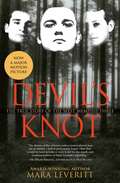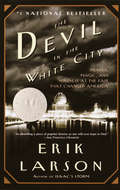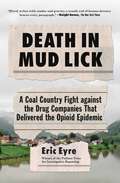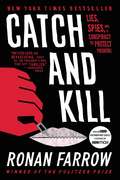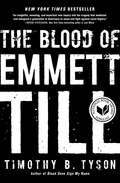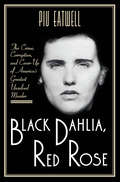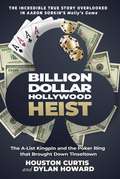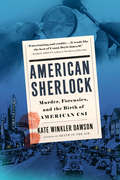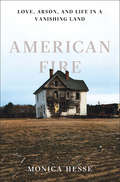Special Collections
True Crime Books
Description: Read all about the darkest parts of our crime obsession: the real stories. #adults
- Table View
- List View
Devil's Knot
by Mara Leveritt*SOON TO BE A MAJOR MOTION PICTURE STARRING REESE WITHERSPOON AND COLIN FIRTH * The West Memphis Three. Accused, convicted...and set free. Do you know their story?In 2011, one of the greatest miscarriages of justice in American legal history was set right when Damien Echols, Jason Baldwin, and Jessie Misskelley were released after eighteen years in prison. Award-winning journalist Mara Leveritt's The Devil's Knot remains the most comprehensive, insightful reporting ever done on the investigation, trials, and convictions of three teenage boys who became known as the West Memphis Three. For weeks in 1993, after the murders of three eight-year-old boys, police in West Memphis, Arkansas seemed stymied. Then suddenly, detectives charged three teenagers--alleged members of a satanic cult--with the killings. Despite the witch-hunt atmosphere of the trials, and a case which included stunning investigative blunders, a confession riddled with errors, and an absence of physical evidence linking any of the accused to the crime, the teenagers were convicted. Jurors sentenced Jason Baldwin and Jessie Misskelley to life in prison and Damien Echols, the accused ringleader, to death. The guilty verdicts were popular in their home state--even upheld on appeal--and all three remained in prison until their unprecedented release in August 2011.With close-up views of its key participants, this award-winning account unravels the many tangled knots of this endlessly shocking case, one which will shape the American legal landscape for years to come.
The Devil in the White City
by Erik Larson#1 NATIONAL BESTSELLER • NATIONAL BOOK AWARD FINALIST • From the #1 New York Times bestselling author of The Splendid and the Vile comes the true tale of the 1893 World's Fair in Chicago and the cunning serial killer who used the magic and majesty of the fair to lure his victims to their death. &“As absorbing a piece of popular history as one will ever hope to find.&” —San Francisco ChronicleCombining meticulous research with nail-biting storytelling, Erik Larson has crafted a narrative with all the wonder of newly discovered history and the thrills of the best fiction.Two men, each handsome and unusually adept at his chosen work, embodied an element of the great dynamic that characterized America&’s rush toward the twentieth century. The architect was Daniel Hudson Burnham, the fair&’s brilliant director of works and the builder of many of the country&’s most important structures, including the Flatiron Building in New York and Union Station in Washington, D.C. The murderer was Henry H. Holmes, a young doctor who, in a malign parody of the White City, built his &“World&’s Fair Hotel&” just west of the fairgrounds—a torture palace complete with dissection table, gas chamber, and 3,000-degree crematorium. Burnham overcame tremendous obstacles and tragedies as he organized the talents of Frederick Law Olmsted, Charles McKim, Louis Sullivan, and others to transform swampy Jackson Park into the White City, while Holmes used the attraction of the great fair and his own satanic charms to lure scores of young women to their deaths. What makes the story all the more chilling is that Holmes really lived, walking the grounds of that dream city by the lake.The Devil in the White City draws the reader into the enchantment of the Guilded Age, made all the more appealing by a supporting cast of real-life characters, including Buffalo Bill, Theodore Dreiser, Susan B. Anthony, Thomas Edison, Archduke Francis Ferdinand, and others. Erik Larson&’s gifts as a storyteller are magnificently displayed in this rich narrative of the master builder, the killer, and the great fair that obsessed them both.
Death in Mud Lick
by Eric EyreFrom a Pulitzer Prize–winning reporter from the smallest newspaper ever to win the prize in the investigative reporting category, an urgent, riveting, and heartbreaking investigation into the corporate greed that pumped millions of pain pills into small Appalachian towns, decimating communities.
Death in Mud Lick is the story of a pharmacy in Kermit, West Virginia, that distributed 12 million opioid pain pills in three years to a town with a population of 382 people—and of one woman, desperate for justice, after losing her brother to overdose. Debbie Preece’s fight for accountability for her brother’s death took her well beyond the Sav-Rite Pharmacy in coal country, ultimately leading to three of the biggest drug wholesalers in the country. She was joined by a crusading lawyer and by local journalist, Eric Eyre, who uncovered a massive opioid pill-dumping scandal that shook the foundation of America’s largest drug companies—and won him a Pulitzer Prize.
Part Erin Brockovich, part Spotlight, Death in Mud Lick details the clandestine meetings with whistleblowers; a court fight to unseal filings that the drug distributors tried to keep hidden, a push to secure the DEA pill-shipment data, and the fallout after Eyre’s local paper, the Gazette-Mail, the smallest newspaper ever to win a Pulitzer Prize for investigative reporting, broke the story. Eyre follows the opioid shipments into individual counties, pharmacies, and homes in West Virginia and explains how thousands of Appalachians got hooked on prescription drugs—resulting in the highest overdose rates in the country.
But despite the tragedy, there is also hope as citizens banded together to create positive change—and won. A work of deep reporting and personal conviction, Eric Eyre’s intimate portrayal of a national public health crisis illuminates the shocking pattern of corporate greed and its repercussions for the citizens of West Virginia—and the nation—to this day.
Catch and Kill
by Ronan FarrowIn a dramatic account of violence and espionage, Pulitzer Prize-winning investigative reporter Ronan Farrow exposes serial abusers and a cabal of powerful interests hell-bent on covering up the truth, at any cost.
In 2017, a routine network television investigation led Ronan Farrow to a story only whispered about: one of Hollywood's most powerful producers was a predator, protected by fear, wealth, and a conspiracy of silence. As Farrow drew closer to the truth, shadowy operatives, from high-priced lawyers to elite war-hardened spies, mounted a secret campaign of intimidation, threatening his career, following his every move, and weaponizing an account of abuse in his own family.
All the while, Farrow and his producer faced a degree of resistance they could not explain -- until now. And a trail of clues revealed corruption and cover-ups from Hollywood to Washington and beyond.
This is the untold story of the exotic tactics of surveillance and intimidation deployed by wealthy and connected men to threaten journalists, evade accountability, and silence victims of abuse. And it's the story of the women who risked everything to expose the truth and spark a global movement.Both a spy thriller and a meticulous work of investigative journalism, Catch and Kill breaks devastating new stories about the rampant abuse of power and sheds far-reaching light on investigations that shook our culture.
A New York Times Bestseller
Blood Will Out
by Walter KirnIn the summer of 1998, Walter Kirn--then an aspiring novelist struggling with impending fatherhood and a dissolving marriage--set out on a peculiar, fateful errand: to personally deliver a crippled hunting dog from his home in Montana to the New York apartment of one Clark Rockefeller, a secretive young banker and art collector who had adopted the dog over the Internet.
Thus began a fifteen-year relationship that drew Kirn deep into the fun-house world of an outlandish, eccentric son of privilege who ultimately would be unmasked as a brazen serial impostor, child kidnapper, and brutal murderer. Kirn's one-of-a-kind story of being duped by a real-life Mr. Ripley takes us on a bizarre and haunting journey from the posh private clubrooms of Manhattan to the hard-boiled courtrooms and prisons of Los Angeles. As Kirn uncovers the truth about his friend, a psychopath masquerading as a gentleman, he also confronts hard truths about himself. Why, as a writer of fiction, was he susceptible to the deception of a sinister fantasist whose crimes, Kirn learns, were based on books and movies? What are the hidden psychological links between the artist and the con man? To answer these and other questions, Kirn attends his old friend's murder trial and uses it as an occasion to reflect on both their tangled personal relationship and the surprising literary sources of Rockefeller's evil.
This investigation of the past climaxes in a tense jailhouse reunion with a man whom Kirn realizes he barely knew--a predatory, sophisticated genius whose life, in some respects, parallels his own and who may have intended to take another victim during his years as a fugitive from justice: Kirn himself. Combining confessional memoir, true crime reporting, and cultural speculation, Blood Will Out is a Dreiseresque tale of self-invention, upward mobility, and intellectual arrogance. It exposes the layers of longing and corruption, ambition and self-delusion beneath the Great American con.
Blood Runs Coal
by Mark A. BradleyA vivid account of “one of the most shocking episodes in organized labor’s blood-soaked history” (Steve Halvonik, Pittsburgh Post-Gazette). In the early hours of New Year’s Eve 1969, in the small soft coal mining borough of Clarksville, Pennsylvania, longtime trade union insider Joseph “Jock” Yablonski and his wife and daughter were brutally murdered in their old stone farmhouse. Behind the assassination was the corrupt president of the United Mine Workers of America (UMWA), Tony Boyle, who had long embezzled UMWA funds, silenced intra-union dissent, and served the interests of Big Coal companies—and would do anything to maintain power. The most infamous crimes in the history of American labor unions, the Yablonski murders catalyzed the first successful rank-and-file takeover of a major labor union in modern US history. Blood Runs Coal is an extraordinary portrait of one of the nation’s major unions on the brink of historical change.
The Blood of Emmett Till
by Timothy B. TysonThis extraordinary New York Times bestseller reexamines a pivotal event of the civil rights movement—the 1955 lynching of Emmett Till—&“and demands that we do the one vital thing we aren&’t often enough asked to do with history: learn from it&” (The Atlantic). * A New York Times Notable Book * A Washington Post Notable Book * Longlisted for the National Book Award * Winner of the Robert F. Kennedy Book Award *An NPR, Los Angeles Times, and Atlanta Journal-Constitution Best Book of the Year *In 1955, white men in the Mississippi Delta lynched a fourteen-year-old from Chicago named Emmett Till. His murder was part of a wave of white terrorism in the wake of the 1954 Supreme Court decision that declared public school segregation unconstitutional. Only weeks later, Rosa Parks thought about young Emmett as she refused to move to the back of a city bus in Montgomery, Alabama. Five years later, Black students who called themselves &“the Emmett Till generation&” launched sit-in campaigns that turned the struggle for civil rights into a mass movement. Till&’s lynching became the most notorious hate crime in American history. But what actually happened to Emmett Till—not the icon of injustice, but the flesh-and-blood boy? Part detective story, part political history, The Blood of Emmett Till &“unfolds like a movie&” (The Atlanta Journal-Constitution), drawing on a wealth of new evidence, including a shocking admission of Till&’s innocence from the woman in whose name he was killed. &“Jolting and powerful&” (The Washington Post), the book &“provides fresh insight into the way race has informed and deformed our democratic institutions&” (Diane McWhorter, Pulitzer Prize–winning author of Carry Me Home) and &“calls us to the cause of justice today&” (Rev. Dr. William J. Barber, II, president of the North Carolina NAACP).
Black Dahlia, Red Rose
by Piu EatwellWith startling new evidence, this gripping reexamination of the Black Dahlia murder offers a definitive theory of a quintessential American crime.
Los Angeles, 1947. A housewife out for a walk with her baby notices a cloud of black flies buzzing ominously in Leimert Park. An "unsightly object" is identified as the mutilated body of Elizabeth Short, an aspiring starlet from Massachusetts who had been lured west by the siren call of Hollywood. Her killer would never be found, but Short’s death would bring her the fame she had always sought. Her murder investigation transformed into a real-life film noir, featuring corrupt cops, femmes fatales, gun-slinging gangsters, and hungry reporters, replete with an irresistible, legendary moniker adapted from a recent film—The Black Dahlia.
For over half a century this crime has maintained an almost mythic place in American lore as one of our most inscrutable cold cases. With the recently unredacted FBI file, newly released sections of the LAPD file, and exclusive interviews with the suspect’s family, relentless legal sleuth Piu Eatwell has gained unprecedented access to evidence and persuasively identified the culprit. Black Dahlia, Red Rose layers these findings into a gritty, cinematic retelling of the haunting tale.
As Eatwell chronicles, among the first to arrive at the grisly crime scene was Aggie Underwood, the "tough-as-nails" city editor for the Los Angeles Evening Herald & Express; meanwhile, the chain-smoking city editor for the Los Angeles Examiner, Jimmy Richardson, sent out his own reporters. Eatwell reveals how, through a cutthroat race to break news and sell papers, the public image of Elizabeth Short was distorted from a violated beauty to a "man crazy delinquent." As rumors of various boyfriends circulated, the true story of the complex young woman ricocheting between jobs, lovers, and homes was lost. Instead, kitschy headlines tapped into a wider social anxiety about the city’s "girl problem," and Short’s black chiffon and smoldering gaze become a warning for "loose" women coming of age in postwar America.
Applying her own background as a lawyer to the surprising new evidence, Eatwell ultimately exposes many startling clues to the case that have never surfaced in public. From the discovery of Elizabeth’s notebook, inscribed with the name of the city’s most notorious and corrupt businessman, to a valid suspect plucked from the hundreds of "confessing Sams" by a brilliant, well-meaning doctor, Eatwell compellingly captures every "big break" in the police investigation to reveal a truly viable resolution to the case. In rich, atmospheric prose, Eatwell separates fact from fantasy to expose the truth behind the sinewy networks of a noir-tinged Hollywood. Black Dahlia, Red Rose at long last accords the Elizabeth Short case its due resolution, providing a reliable and enduring account of one of the most notorious unsolved murders in American history.
Billion Dollar Hollywood Heist
by Dylan Howard and Houston Curtis&“Right out of the gate, the entire game was designed to empty the pockets of those rich, celeb-loving LA suckers.&”—Houston Curtis Leonardo DiCaprio. Alex Rodriguez. Tobey Maguire. Ben Affleck. Matt Damon. John Cassavetes. What do these people have in common? Not just fame and fortune; all these men are also alumni of the ultra-exclusive, high-stakes poker ring that inspired Aaron Sorkin&’s Oscar-nominated film, Molly&’s Game. But Houston Curtis, the card shark who co-founded the game with Tobey Maguire, knows that Sorkin&’s is the whitewashed version. In Billion Dollar Hollywood Heist, Curtis goes all-in, revealing the true story behind the game. From its origins with Maguire to staking DiCaprio&’s first game, installing Molly Bloom, avoiding the hookers and blow down the hall, and weathering the FBI investigation that left Curtis with a lien on his house, this is the no-holds-barred account of the world&’s most exclusive Texas Hold &’Em game from the man who started it—with all the names and salacious details that Molly&’s Game left out. With the insider appeal of Rounders, more A-listers than Ocean&’s 11, and the excitement of The Sting, Billion Dollar Hollywood Heist is the untold, insider&’s story that makes Molly&’s Game look tame.
American Sherlock
by Kate Winkler DawsonFrom the acclaimed author of Death in the Air ("Not since Devil in the White City has a book told such a harrowing tale"--Douglas Preston) comes the riveting story of the birth of criminal investigation in the twentieth century.Berkeley, California, 1933. In a lab filled with curiosities--beakers, microscopes, Bunsen burners, and hundreds upon hundreds of books--sat an investigator who would go on to crack at least two thousand cases in his forty-year career. Known as the "American Sherlock Holmes," Edward Oscar Heinrich was one of America's greatest--and first--forensic scientists, with an uncanny knack for finding clues, establishing evidence, and deducing answers with a skill that seemed almost supernatural.Heinrich was one of the nation's first expert witnesses, working in a time when the turmoil of Prohibition led to sensationalized crime reporting and only a small, systematic study of evidence. However with his brilliance, and commanding presence in both the courtroom and at crime scenes, Heinrich spearheaded the invention of a myriad of new forensic tools that police still use today, including blood spatter analysis, ballistics, lie-detector tests, and the use of fingerprints as courtroom evidence. His work, though not without its serious--some would say fatal--flaws, changed the course of American criminal investigation. Based on years of research and thousands of never-before-published primary source materials, American Sherlock captures the life of the man who pioneered the science our legal system now relies upon--as well as the limits of those techniques and the very human experts who wield them.
American Fire
by Monica HesseThe arsons started on a cold November midnight and didn’t stop for months. Night after night, the people of Accomack County waited to see which building would burn down next, regarding each other at first with compassion, and later suspicion. Vigilante groups sprang up, patrolling the rural Virginia coast with cameras and camouflage. Volunteer firefighters slept at their stations. The arsonist seemed to target abandoned buildings, but local police were stretched too thin to surveil them all. Accomack was desolate—there were hundreds of abandoned buildings. And by the dozen they were burning.
